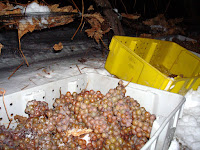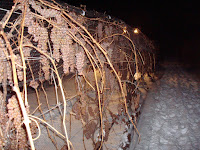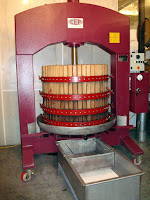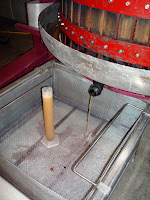Blanc d'Alsace (2006)Today's wines takes us to the heavily Germanic influenced region of Alsace in northeastern France. This area has changed hands between France and Germany a number of times throughout history, surely due to both wanting to claim the great wines produced there as their own! The only region in France that is permitted to use German grape varieties under the AOC system, Alsace is primarily known for white wine (90% of production) from aromatic varietals including Riesling and Gewürztraminer.
Maison Kuentz Bas
60% Sylvaner | 15% Muscat | 15% Auxerrois | 10% Chasselas
Husseren-les-Chateaux, France
Crustacés (2007)
Dopff & Irion
Riesling
Riquewihr, France
Alsace Pinot Noir (2006)
Robert Klingenfus
Pinot Noir
Molsheim, France
Alsace is considered to have a cooler climate and wine styles are influenced by two important geographical features: the Vosges mountain range and the Rhine River. With most of the vineyards planted on slopes between the two, the Vosges protect the vines from wind and also minimize rain fall while the Rhine encourages air flow and prevents rot from occurring. These factors result in dry sunny days which contribute to the concentrated characteristics displayed in many Alsatian wines, giving pronounced aromas and flavors and crisp, full acidity.
Blanc d'AlsaceThis was an interesting blend focused around some of the lesser known grapes found in Alsace. Sylvaner, Muscat, and Chasselas make up less than 15% of grapes grown and have declined in popularity over the years. Auxerrois is often grouped with Pinot Blanc because of their similarities and is considered to be a relative of the Chardonnay grape. Just on a whim I sampled this with some French goat cheese and it was killer. This is a definite food wine.
Appearance: Clear white wine with medium color, somewhere between gold and straw. I wouldn't go so far as to call it "deep" in color, but it's almost there. Very distinct from lighter whites like Pinot Grigio.
Nose: Clean, developing in age, light oak, pronounced minerality, and unmistakable lemon or other citrus aromas. There is a slight smoky, almost greasy level to the nose - which isn't bad - and very soft pear at the top of the glass.
Palate: Holy cow! Huge acidity, mouth watering and it continues well into the finish. Dry wine with medium alcohol (12.5%), full body, and a long finish. Bursting citrus including lime or lemon but above all else grapefruit. Almost like grapefruit rind. A little oak and herbaceous characteristic, as well as the same minerality from the nose.
CrustacésProducing mostly dry wines, Riesling in Alsace is held in the same high regard as those from Germany. Anyone who avoids Rieslings because of the undue presumption that they are all sweet definitely needs to get a bottle of this. Shrimp and steamed mussels with some lemon and lavender were wonderful paired with this.
Appearance: Clear with a pale golden color. The wine shimmers brightly at the edge of the glass.
Nose: Clean and youthful with moderately intense aromas including lime, pear, apple, and tropical fruit. The nose for this wine is screaming Riesling - fresh green apple is the predominate aroma blending with some pineapple. The other aromas of pear, peach, and floral are all mostly at the top of the glass and much softer.
Palate: Zing again! Dry with moderate to high acidity - my eyes are watering a little here - full bodied wine with medium alcohol (12%) and a long finish. That granny smith continues to fight for the spotlight with an added level of lime. Acidity that has my mouth watering and cheeks twinging.
Klingenfus Pinot NoirThe cherry flavors in this wine were more reminiscent of those tart yellow ones you can find. The combination of tart fruit and earthiness that this wine has really makes it a great example of an old-world style Pinot Noir. I enjoyed carrots and mushrooms seared in wine and butter and seasoned with French herbs with this.
Appearance: A clear, pale red wine. Color is bright and fresh looking - almost a cranberry red.
Nose: Clean with some development, moderate aromas. Lots of red fruits, including strawberry and crab apple, but mostly cherry. Very soft wafts of earthiness and a little dried fruit suggests the old-world origins and development that comes with aging.
Palate: Dry medium bodied wine with bright cranberry-esque acidity. Medium tannins noticeable on gums, medium alcohol (12.5%), with a lengthy finish. Surprisingly the first noticeable flavor was mushroom right at the front of my mouth - some of my favorite wines taste like fruit and dirt! Past this there was a lot of cranberry and cherry as with the nose. Also some hints of strawberry lingered on the finish.
Alsatian cuisine also has a strong German flair and is filled with things like pâtés and sauerkraut. Any of these wines would be an awesome accompaniment to any hearty meal as they all have enough body and acidity to stand up to bold flavors and textures. Think "concentrated" and you can't go wrong. Choosing a wine from Alsace is not as complicated as picking out a good Bordeaux given there are only a few classifications in the region. Look for any of the wines above, which are all reasonably priced (all less than $16), or ask for a recommendation and go from there.
Cheers!









